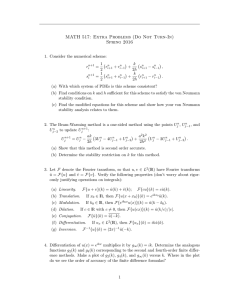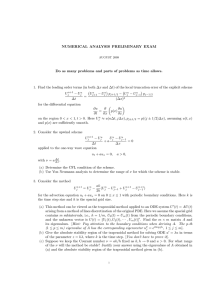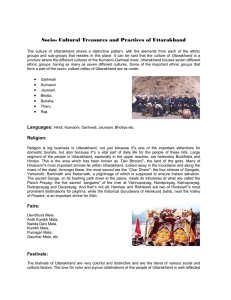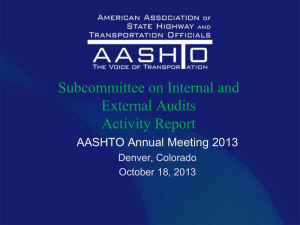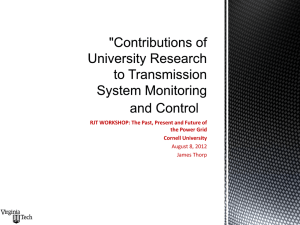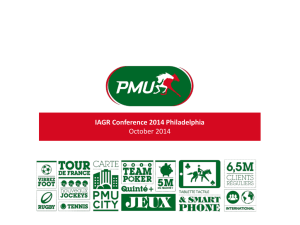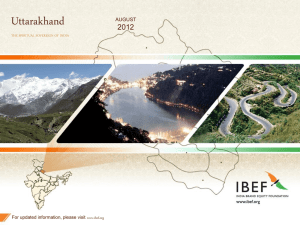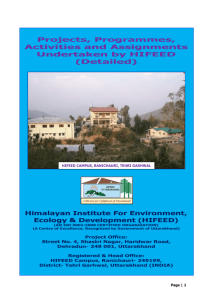Mr.Kapil Lall, Swajal Project
advertisement
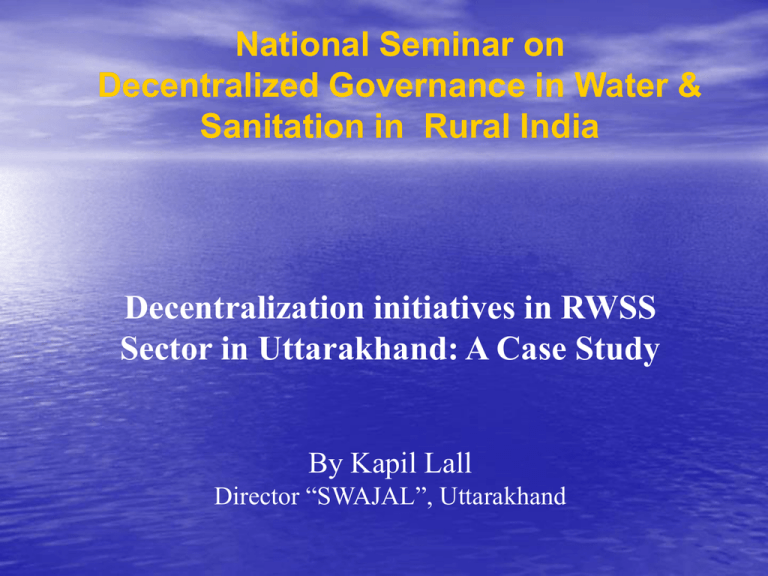
National Seminar on Decentralized Governance in Water & Sanitation in Rural India Decentralization initiatives in RWSS Sector in Uttarakhand: A Case Study By Kapil Lall Director “SWAJAL”, Uttarakhand Background • The sustainable delivery of rural water supply and sanitation service has been a cause of concern for policy planners of the country. • This has led to a paradigm shift in the way the Government now approaches the rural water supply and sanitation sector. • Uttarakhand state is the first state in the country to implement this paradigm shift in both letter and spirit across its entire territory, as a Sector-wide Approach (SWAp). • The objective of this presentation is to share good practices being adopted in the state under the Uttarakhand Rural Water Supply & Sanitation Project (URWSSP) and NRDWP etc. for replicability of the processes in all other parts of the country by adapting to suit their specific situations. URWSSP IN BRIEF • URWSSP is the first project in the RWSS which is based on • • • • • Sector wide approach (SWAp)The project covers entire rural areas of the Uttarakhand State. The project is facilitated by the Department of Drinking Water, GoUK and executed by three agencies namely Uttarakhand Peyjal Nigam (UJN), Uttarakhand Jal Sansthan (UJS) and Project Management Unit (Swajal). The project has a total budget of $ 224 million of which the IDA credit is limited to a maximum of $ 120 million. The Project period is November 2006 to June, 2014. The project aims to benefit about 1.2 million people or about 20% of the rural population and improve sanitation in about 30% of rural communities to be declared free of open defecation. Uniqueness of the Project Sector Wide Approach (SWAp) • Project demonstrates paradigm shift to Sector-wide Approach (SWAp) ‘Global First’ for uniform policies and institutional arrangements • PRIs and local communities plan, procure, construct, operate maintain RWSS facilities • • • • • Community UWSSC Gram Panchayat NGO Social Audit Committee Village Level and • Intra-village SVS & intra-village MVS: full responsibility of Gram Panchayats • DIAs DWSC DWSM District Level • Bulk Water Supply MVS: responsibility of sector institution. • • Three implementing agencies (UJN, • • State PMU/ UJN/UJS SWSM DWD State Level UJS and Swajal) working in synergy for implementing the SWAp Striving to give the community a voice 4 RWSS INSTITUTIONAL ARRANGEMENTS FUND FLOW MECHANISM The funds from the State Govt. flow directly to the State level implementing agencies (PMU, UJN and UJS). The funds from the State level are transferred to the district level institutions of PMU, UJN and UJS, based on Annual Work Plans and Budgets. GoUK GoUK GoUK PMU PMU PMU HQ HQ HQ UJN HQ UJN HQ UJS UJS UJS HQ HQ HQ DPMU DPMU DIA-UJN DIA-UJN DIA-UJS DIA-UJS GP UWSSC UWSSC Beneficiary Processes Followed O&M Phase Implementation Planning Pre Planning 0 3 6 9 12 15 18 21 24 27 30 33 36 39 42 Months Process: Planning Phase SO Awareness Creation, Organizing Community into Groups, Trainings Monitoring & Public Disclosure Monthly Progress Report by SO to DIA Record Keeping by UWSSC Wall Writing/Hoardings Community Wide Meeting UWSSC Formation & Opening Capital and O&M Account Web based monitoring system. Collection of Upfront Contribution Continuous monitoring by DIA Feasibility & Agree-To-Do Meeting Concurrent monitoring by Third Party. Preparation of Community Action Plan DPR & Implementation Phase Proposal Review by DWSC Yes Approval by Yes DWSM Signing of IPQA Grievances redressal in community wide meetings. 8 Process: Implementation Phase Fulfillment of Payment Conditions by GP/UWSSC SO • Training & Capacity Building • Management Support to GP/UWSSC Funds Release to GP by DIA Transfer to Funds from GP to UWSSC UWSSC/GP • • • • Material Procurement & Construction Collection of balance Contribution Utilization of Fund Record Keeping Quality Control Supervision by Third Party Preparation of IPCR Vetting o IPCR by GP/UWSSC Account Settlement by DIA/DWSM Start of O&M Phase 9 Process: O&M Phase SO DIA • Exit from the village after 4 months • Technical Support to UWSSC • • • • Refresher Training Handholding on Maintenance of Account Establishment Of O&M System Exit UWSSC/GP • • • • • O&M of Scheme Collection of O&M Tariff Enforcing Bye Laws Sanction new connection Record Keeping 10 INNOVATIONS AT A GLANCE Planning Unit: Habitation Legal Status to UWSSC Model Bye-laws for UWSSC Grievance redressal Integrated delivery Social Audit Committee Constitution of TRC URWSSP Single Set of Schedule of Rates Elaborate Exit Strategy Insurance of schemes Fine-tuning of SOs Selection Criteria Online M&E IEC HRD Community Contracting MVS vs SVS Capacity building of all stakeholders ‘Agree-To-Do’ meeting for finalization of technological option Training on documentation & account keeping maintenance FTK training Wall writing Social Audit Committee Wall Writing of Social Audit Committee Social Audit Committee • The Gram Panchayat will directly constitute a Social Audit Committee with five members for a period of two years. The Committee members; • Should be respectable members of the community and on whom the poor have faith. • Not immediately related to the GP members or UWSSC members. • Should not be members of any of the decision making committees • At least three members should be from target population. The Social audit Committee will perform the following functions: • Ensure that all the committees follow Procurement Manual. • Report any violation or deviation of rules to Gram Panchayat. • Monitor the adherence of project principles and rules in selection of beneficiaries, implementation of sub projects and all decisions of UWSSC. 15 Monitoring and performance tracking Web based monitoring Exit: Withdrawal from village Empowered Community X-Ray of all Works Done Public Interest Disclosure in community wide meeting Inventorization of Assets Transfer of Assets & Tools Trouble Free Sustainable O&M Impacts • Building Local capacities: The new decentralized approach has been received with a high level of enthusiasm from local governance institutions. By building the capacity of these institutions to design, implement and manage their own works - in addition to managing procurement, finances and accounting- they have been equipped to take on other development projects in their areas, whether under MNREGA or any other program. • Eliminating Layers of bureaucracy: Decentralization to local communities has eliminated layers of bureaucracy, reducing the scope for leakage of funds - an estimated 40 percent of funds deployed. time and expenses involved in lodging complaints with the authorities, paying bills, getting corrections in wrong bills, and getting sanctions for new water connections. Repairs are now much quicker and more long-lasting because of the strict supervision exercised by local communities. Impacts • Savings for state exchequer: Detailed assessments show that by decentralizing service delivery to local communities, the state government’s savings include: savings in institutional costs and O&M costs. Thus the State Government has to provide lesser budgetary support through State Exchequer as GP meets the O&M expenses including energy costs. • Greater availability of time for Line Departments: GP/UWSSC takes up the full responsibility of O&M, with back-up support by the UJS, as and when required. Thus line department have more availability of time for managing complex schemes and lesser management problems. Impacts • Communities have the following advantages: • lesser dependence on outsiders for water supply service i.e. Gram • • • • Swaraj (Village Self Rule)- leading to ‘community pride’ & ‘community control’. reduction in coping cost as well as more availability of house hold space due to elimination of storing water in larger containers elimination of travel time and travel cost in lodging no-water complaints, making payment of bills and getting sanction of new water connection Improvement in Mean Time Between Failure (MTBF) due to better quality of repairs and strict control/supervision by the community. Reduction in women’s drudgery of about 2-3 hours per day leading to better quality of life i.e. utilization of their quality time in caring their children and leisure time besides income generation in some cases. Thanks to the empowered community for keeping the SWAp philosophy and program on the path to success ! 21
